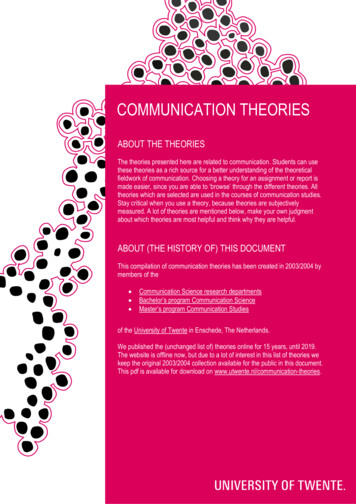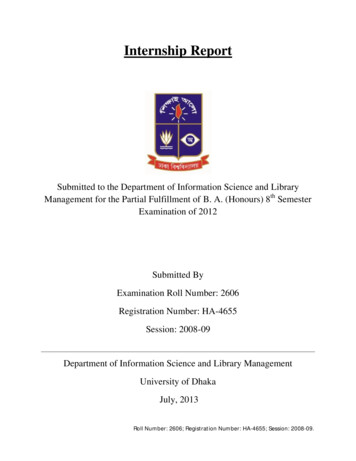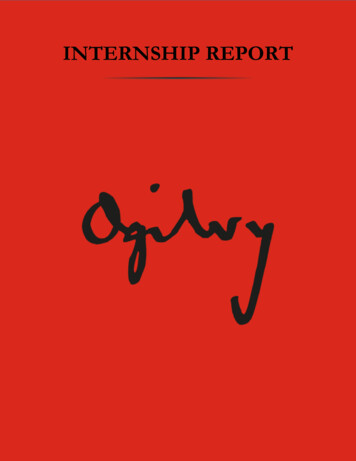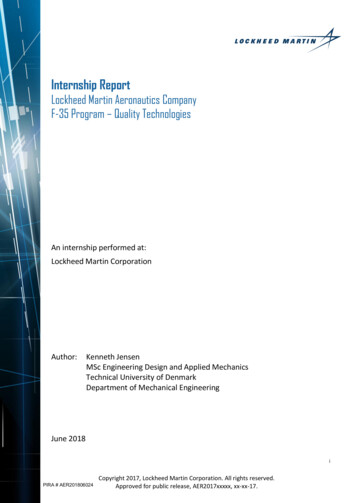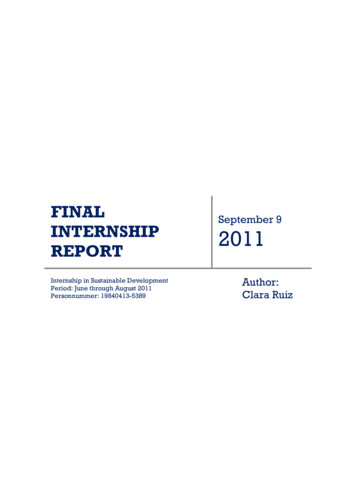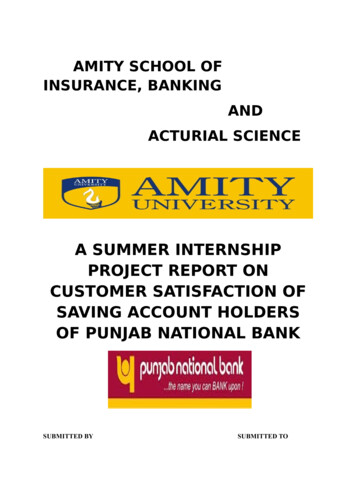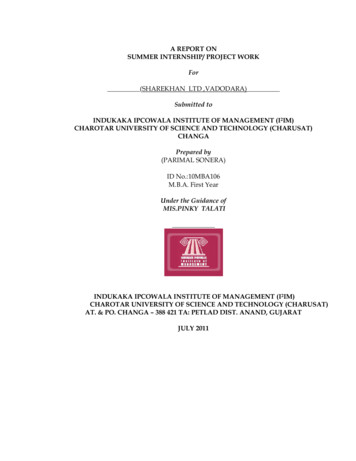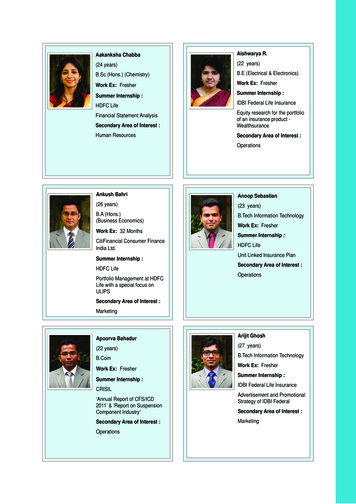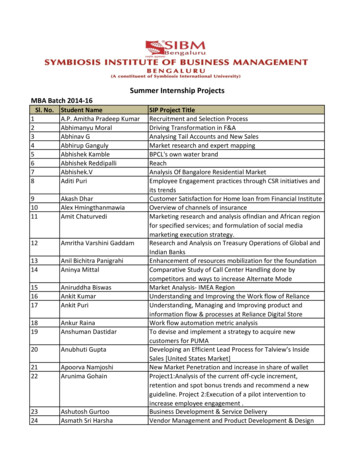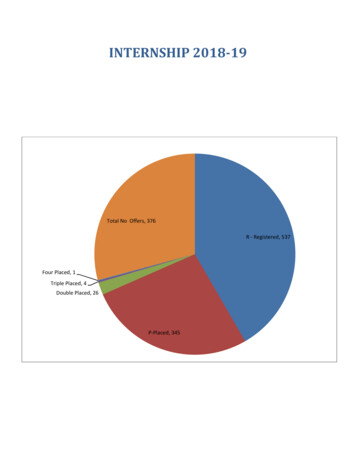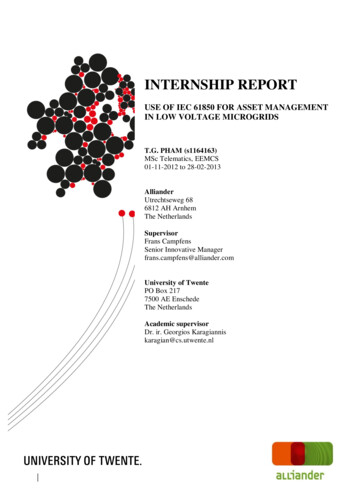
Transcription
INTERNSHIP REPORTUSE OF IEC 61850 FOR ASSET MANAGEMENTIN LOW VOLTAGE MICROGRIDST.G. PHAM (s1164163)MSc Telematics, EEMCS01-11-2012 to 28-02-2013AllianderUtrechtseweg 686812 AH ArnhemThe NetherlandsSupervisorFrans CampfensSenior Innovative Managerfrans.campfens@alliander.comUniversity of TwentePO Box 2177500 AE EnschedeThe NetherlandsAcademic supervisorDr. ir. Georgios Karagianniskaragian@cs.utwente.nl
Preface and acknowledgementFor four months from November 2012 till February 2013, I did an internship at Alliander, anenergy distribution company which covers large areas in the Netherlands. Alliander corebusiness involves distributing gas and electricity to a huge amount of customers which isabout nearly a third of the Netherland’s population. This internship project is a part of my 2year master program which I conduct at University of Twente, the Netherlands.Figure 0.1 – Alliander electricity and gas distribution grid, copied from [12]I worked on an assignment project to investigate the use of the IEC 61850 standard for assetmanagement of LV Microgrids. The main content of the project is to use the IEC 61850standardized data model and services to model the smart electrical equipment, and investigatethe interaction between different components within a network topology for Microgrids assetmanagement. This topic suits my major in telematics, and also brought me to a very new andinteresting area of using communication technologies in electricity network. Through theassignment, I did not only gain a lot of knowledge but more importantly, I also had a greatchance to sharpen my skills in a professional working environment. Not less important thanthe communication technologies that I have learnt is the communication skills that I havei
been trained and practiced through giving presentations, discussing with the supervisors,experts in the field and other staffs within and outside the company.I am very appreciated to Mr. Frans Campfens, my supervisor at Alliander. Frans gave mevery in-time valuable instructions and put me in contact with experts in the field like Mr.Marco Janssen, president and CEO at UTInnovative, who gave me extensive guidanceregarding many practical issues. I also would like to express my gratitude to Dr. ir. G.Karagiannis for his permission to be my academic supervisor and more importantly for hisenthusiastic encouragements and precious instructions during my internship period. He gaveme in-time feedback on my research and helped to organize an interesting presentation inwhich I could present my ideas and achievements to other professors and researchers of thefaculty.Throughout the internship, I have also learnt many things about the Dutch culture whosebenefits are far beyond what I could learn in a normal project. In short, I would like to thankAlliander and University of Twente, Internship Office for introducing me to this greatopportunity in which I have developed myself both academically, professionally and socially.ii
Table of contentsList of Figures . vList of Tables . viiList of Abbreviations. viiiChapter 1: Introduction . 11.1 Problem statement and research objectives . 21.1.1 Problem statement . 21.1.2 Research Objectives . 21.2 Organisation of this report . 3Chapter 2: Technical descriptions . 42.1 Description of IEC 61850 . 42.1.1 Scope of IEC 61850 . 42.1.2 Standardization approach. 52.1.3 Content of the IEC 61850 series . 62.1.4 Extensibility of IEC 61850 . 82.1.5 IEC 61850 data modelling principle . 82.1.6 IEC 61850 communication services . 102.1.7 Specific communication service mapping . 132.2 Smart Grid and Microgrids . 202.2.1 Smart Grid. 212.3. Summary . 222.2.2 Microgrids . 23Chapter 3: IEC 61850 network designing and data modelling for microgridscomponents . 253.1 Communication network designing . 253.1.1 Microgrids power diagram. 253.1.2 Communication network topology for LV Microgrids power control and assetmanagement . 263.2 IEC 61850 data modelling . 293.2.1 Extension rule for logical nodes . 30iii
3.2.2 IEC 61850 data modelling for Microgrids components . 313.3 Summary . 37Chapter 4: Applying IEC 61850 data models and services for microgrids for LVmicrogrid asset management . 394.1 Overview on asset management . 394.2 Asset management use case . 424.2.1 Description of the Use Case . 424.2.2 Actor (Stakeholder) Roles . 434.2.3 Information exchanged . 434.2.4 Step by Step Analysis of Function . 444.3 Realization of use case with IEC 61850 . 494.3.1 Scenario 1 . 494.3.2 Scenario 2 . 634.3.3 Mapping ACSI services to MMS . 664.4. Summary . 68Chapter 5: Conclusion and future work . 69References. 71iv
List of FiguresFigure 2.1 – Scope of application of IEC 61850, copied from [1] . 5Figure 2.2 – Links between IEC 61850 parts, copied from [1] . 7Figure 2.3 – IEC 61850 specifying approach, copied from [1] . 8Figure 2.4 – Relationship between functions, logical nodes and physical nodes, copied from[1] . 9Figure 2.5 – Overview of IEC 61850 functionality and profiles, copied from [4] . 14Figure 2.6 – GOOSE and SV peer-to-peer data value publishing model, copied from [4] . 18Figure 2.7 – Sampled value mapped to serial unidirectional multidrop point to point link,copied from [23] . 19Figure 2.8 – Transformation from traditional to future electricity grid, copied from [12] . 21Figure 2.9 – Conceptual model of smart grid, copied from [13] . 22Figure 2.10 – Microgrids architecture, copied from [16] . 23Figure 3.1 – LV microgrids diagram . 26Figure 3.2 – Communication network topology for LV Microgrids power control and assetmanagement . 28Figure 3.3 – IEC 61850 data modeling, copied from [1] . 29Figure 3.4 – Basic extension rules diagram, copied from [3]. 30Figure 3.5 – Conceptual organization of DER logical devices and logical nodes, copied from[7] . 32Figure 3.6: Logical devices in proxies or gateways . 37Figure 4.1: Message flow for Scenario 1 of Asset Management use case . 46Figure 4.2: Message flow for Scenario 2 of Asset Management use case . 48Figure 4.3: TWO-PARTY-APPLICATION-ASSOCIATION (TPAA) class syntax [4] . 49Figure 4.4: Relations between classes in an IEC 61850 server . 50Figure 4.5: Instantiation of generic classes . 51Figure 4.6: IEC 61850 server structure and the related services . 52Figure 4.7: Example of GetServerDirectory and GetServerDirectory service used by HCMC. 54Figure 4.8: A reference with a functional constraint . 56v
Figure 4.9: Example of GetDataValues service used by HCMC . 57Figure 4.10: Example of GetAllDataValues service used by HCMC. 59Figure 4.11: HCMC retrieves device name plate information . 61Figure 4.12: An example of report service configuration . 63Figure 4.13: HCMC performs health monitoring using GetDataValues service. 64Figure 4.14: HCMC uses reporting services on the device to perform health monitoring . 65Figure 4.15: HCMC uses reporting service on a switch to detect communication problems . 66Figure 4.16: Mapping GetDataValues to MMS Read service to get measurement value . 68vi
List of TablesTable 2.1 – ACSI classes [4] . 11Table 2.2 – Service and protocols for GSE management and GOOSE communication Aprofile [8] . 16Table 2.3 – GOOSE/GSE T-profile [8] . 17Table 2.4 – Time Sync A-Profile [8] . 20Table 3.1 – Smart household appliances and their typical characteristics . 33Table 3.2 – ZAPL class . 34Table 3.3 – Extension to STMP class . 35Table 3.4 – ZHCM class. 36Table 4.1: Additional Bridge-data objects in LPHDB added to LN LPHD [17] . 41Table 4.2: Additional Bridge-data objects in LCCHB added to LN LCCH [17] . 41Table 4.3: Actor (Stakeholder) Roles. 43Table 4.4: Information exchanged between actors . 43Table 4.5: Precondition
INTERNSHIP REPORT USE OF IEC 61850 FOR ASSET MANAGEMENT IN LOW VOLTAGE MICROGRIDS T.G. PHAM (s1164163) MSc Telematics, EEMCS 01-11-2012 to 28-02-2013 Alliander Utrechtseweg 68 6812 AH Arnhem The Netherlands Supervisor Frans Campfens Senior Innovative Manager frans.campfens@alliander.com University of Twente PO Box 217 7500 AE Enschede The
